Hanomag armored personnel carriers: SdKfz 250 and SdKfz 251
In almost any film, German soldiers with rolled-up sleeves shoot exclusively from submachine guns and move across the conquered territories on the “Hanomag”; this image went down in history and human memory so much. The appearance of such a simplified image, which went on television screens and books, was facilitated by a recognizable type of German armored personnel carriers with an elongated low silhouette of chopped forms and a chassis, which was distinguished by the chess arrangement of rollers. And the cars themselves were massive enough. Light SdKfz 250 armored personnel carriers were released 7326 in all versions, and medium SdKfz 251 - 15252.
In terms of the number of SdKfz 251 armored personnel carriers produced, it was second only to the American M3 armored personnel carrier. At the same time during the war SdKfz 251 was not only in service with the German parts, in small quantities they were supplied to the allies of Germany. Moreover, with the end of World War II, military service for these armored personnel carriers did not end. In the post-war years, its modernized version called Tatra OT-810 was produced in Czechoslovakia up to the year 1962 at the Podpolyanske Constructed plant in Detva. The armored personnel carrier began to massively decommission the Czechoslovak army only in 1980-s, the last copies of this vehicle were removed from storage in the 1995 year.
High maneuverability and reliable design made these armored personnel carriers in demand on the Soviet-German front and in Africa, that is, in theaters of operations, where there were serious problems with the roads. For example, Sd Kfz 250/3 armored personnel carriers were widely used as mobile radio stations and command posts. One of these armored personnel carriers was the beloved KP of the commander of the African Corps, Field Marshal Erwin Rommel. It is difficult to list all the military professions of these two armored personnel carriers: they were armory a platform for installing anti-tank weapons, rocket artillery, mortars, anti-aircraft mounts, carried sappers, doctors, reconnaissance and signalmen, and many others. In the German army, the Ganomag armored personnel carriers were irreplaceable during the Second World War.
Armored personnel carrier Sd.Kfz.250, Sonderkraftfahrzeug 250
At the end of the 1930-s, the Arms Management Department of the Arms Directorate issued a technical task for the development of a light semi-tracked armored personnel carrier, which was to be an addition to the Sd Kfz 251 armored personnel carrier that was already being mass-produced. As was the case with the predecessor for the light armored personnel carrier, extensive use was made of components and assemblies from the semi-tracked tractor D7p-Zgkw 1 ton (Sd Kfz 10), which was produced by the German company DEMAG in the city of Vetter (Ruhr). At the same time, the armored vehicles of the new combat vehicle were developed by the company Buessing-NAG from Berlin-Oberschenevelde.
The body of the Sd Kfz 251 armored personnel carrier was welded from straight rolled armored plates, which were located at rational inclination angles. There were two main options for the manufacture of his body - the old version (alt) and new (neu). The neu case had a simpler design, it was assembled from fewer parts (9 instead of 19 in the case of alt case). Sd Kfz 250 / 1 was the main version of the armored personnel carrier. All other models were simply created on its base. The Sd Kfz 250 / 1 armored personnel carrier could carry half of the grenadier units (Halbgruppe), a 4 man. The crew of the car consisted of two people: the driver and the commander, who at the same time served as radio operator.
The body of the Sd Kfz 250 armored personnel carrier consisted of two parts - a force and combat compartment. In the front of the case was located the power compartment, and in the middle and rear parts - combat. In the fighting compartment there was a driver-mechanic, the commander of an armored personnel carrier, as well as airborne soldiers or additional weapons (for example, a mortar or anti-tank gun). Also in the fighting compartment installed the necessary radio equipment. The hull was made of heterogeneous armor plates with a cemented outer surface. The front, side and stern hulls of the Sd Kfz 250 hull were up to 14,5 mm, and the thickness of the roof of the power compartment and the bottom was 8 mm.
Behind the power compartment, in which the engine, fuel tanks and front axle control device were located, behind the firebreak in the front part of the combat compartment, the places of the commander and driver of the armored personnel carrier were equipped. The driver used a dashboard with a pressure gauge (oil), a thermometer (water), a speedometer, a tachometer, and indicator lights. The driver controlled the vehicle with the help of automobile controls: a steering wheel and three standard pedals (clutch, gas and brake). On the right side of the driver's seat was located the gearshift lever, as well as the handbrake lever. In the right part of the fighting compartment was the place of the commander of the combat vehicle or soldier responsible for loading and unloading ammunition (Sd Kfz 252). Along both sides of the combat compartment of the armored personnel carrier there were benches for the landing troops. Initially these were seats covered with leatherette, but later on the Germans began to use tubular frames with stretched tarpaulin as benches. There have also been cases of the use of wooden benches. Inside, on the walls of the fighting compartment, there were mounts for weapons of the landing troops: 9-mm machine guns MP 38 (MP 40) and 7,92-mm Mauser 98k rifles.
On the specialized versions of the armored personnel carrier, the combat compartment was redone accordingly, so that it could carry a gun or an additional radio station. Overall pins and headlights or one headlight were attached to the front wings of the car. On the left wing was mounted spotlight Notek. In the Sd Kfz 250 aft there were two position lights, also an antenna was attached to the stern of the armored personnel carrier. Here there was also a single-door entrance door to the troop compartment, it swung open to the left.
The main armament of the standard version of the Sd Kfz 250 / 1 armored personnel carrier was the 7,92-mm machine gun Reinmetall-Borsig MG 34, which was located in the front of the combat compartment, this machine gun was protected by an armored guard. Ammunition consisted of 2010 cartridges. In the stern of the machine, an additional MG 34 machine gun could be installed, from which it was possible to fire at air targets. The mass of the armored personnel carrier was 5387 kg, and the height (including the shield of the MG 34 machine gun) was 1986 mm.
As the power plant on the Sd Kfz 250 armored personnel carrier was installed a carburetor six-cylinder over-valve engine Maybach HL42 TRKM liquid cooling. The maximum power of this motor was HP 100. at 2800 rpm. The maximum allowable engine speed is 3000 revolutions per minute. The power density was 17,24 HP per ton.
The chassis of the Sd Kfz 250 armored personnel carrier was half-tracked. This means that it moved on wheels (front axle), as well as on tracks (rear drive axle). With the help of the front wheels, it was possible to control an armored personnel carrier, and the tracks provided the combat vehicle with movement and increased cross-country ability. This suspension scheme had a number of advantages, as it allowed the creation of an armored personnel carrier with a cross-country ability comparable to tanks, but characterized by a much simpler device (half-track armored personnel carriers did not need onboard clutches and final drives).
The crawler section of the undercarriage (on each side) consisted of five road wheels on a torsion bar, the latter rink simultaneously being a guide, and also a driving wheel located in front of the crawler section. A screw-type crawler tension device was used on the combat vehicle. The road wheels were produced by stamping from steel sheets 8-12 mm in thickness and were distinguished by the presence of eight facilitating holes. All Sd Kfz 250 road wheels had a rubber band.
Armored personnel carrier SdKfz 251, Sonderkraftfahrzeug 251
The SdKfz 251 medium semi-tracked armored personnel carrier was developed by Hanomag in the 1938 year on the basis of the Sd Kfz 11 three-tonne artillery tractor. It was mass-produced from June 1939 of the year to March of the 1945 year. In the same way as in the case of a light armored personnel carrier, in the undercarriage of the car were used tracks with external rubber pads and needle hinges, a front axle with steered wheels and a staggered arrangement of road wheels. In the transmission of an armored personnel carrier used an ordinary four-speed gearbox. Medium SdKfz 251 armored personnel carriers were produced in Germany in four different versions - Ausf. A, B, C, and D, as well as in the 23 specialized versions, which differed from each other by the weapons and equipment installed on board.
The standard was the Sd.Kfz.251 / 1 combat vehicle, which was put into service in the 1940 year. It was an armored personnel carrier for the transport of infantry, which was armed with one or two 7,92-mm machine guns "Rheinmetall-Borzing" MG-34 (at the end of the war MG-42) with a total ammunition 2010 ammunition. The machine gun in the front of the hull was covered with an armored guard, and located in the stern of the car was mounted on a swivel mount, which allowed firing with large elevation angles. This combat vehicle was designed to carry a motorized infantry unit (10 people). The permanent crew consisted of two people: the commander of the car and the driver. The combat weight of the Sd.Kfz.251 / 1 armored personnel carrier reached 9,14 tons.
The body of the armored personnel carrier was welded from armor plates with a thickness from 6 mm (bottom) to 14,5 mm (forehead). A sufficiently large double hatch, designed to provide access to the engine, was built in the top sheet of the car hood. On the sides of the hood on the version of Sd.Kfz.251 Ausf.A there were vents. The left of them could open the driver with a special lever directly from the cab. Most often, the average half-track armored personnel carrier Sd.Kfz.251 available in versions Sd.Kfz.251 / 1 - infantry transporter, Sd.Kfz.251 / 4 - artillery tractor, Sd.Kfz.251 / 6 - staff vehicle control. Sd.Kfz modifications were produced in much smaller quantities. The 251 / 3 is a communications vehicle and the Sd.Kfz 251 / 10 is an anti-tank version, armed with an 37-mm cannon.
The combat compartment of the armored personnel carrier was open at the top. The roof was only above the places of the commander and driver. The entrance and exit from the fighting compartment was carried out through a double door located in the stern wall of the hull. In the fighting compartment, as in a light armored personnel carrier, two benches were mounted along the sides. In the frontal wall of the cabin, two observation holes were equipped for the driver and the commander with interchangeable observation blocks. On the sides of the department, the management also arranged one small viewing embrasure. In total, there were three viewing instruments on each side, including the instruments of the commander and the driver. Inside the fighting compartment were pyramids for personal weapons of the landing force and racks intended for other military and personal property. To protect members of the landing force from the weather, the designers provided for mounting over the fighting compartment of the canvas awning machine.
On the average Sd Kfz 251 armored personnel carrier the same engine was installed as on the light one. Its maximum power was 100 hp, which, with an increased combat weight, gave a lower specific power - 11,1 hp per ton. The capacity of the fuel tanks of the machine was 160 liters. The fuel tank was located between the power plant and the control room and was fenced off by a fire wall. The fuel consumption of the armored vehicle when driving on the highway was 80-85 liters per 100 km, while driving on rough terrain - 80-85 liters.
The Sd Kfz 251 armored personnel carrier, as well as its light fellow, also possessed a semi-tracked chassis with amendments to the increased dimensions of the vehicle. When making turns at an angle of up to 15 degrees, the combat vehicle was controlled as an ordinary car. When making steeper turns, the special mechanism released the internal track and at the same time transferred part of the power (from 56% to 100%) to the external track. The number of road wheels on an average armored personnel carrier has greatly increased. The first outer row of track rollers included three rollers, the inner row - three rollers, and the middle row - just six track rollers. Under normal conditions, the entire main load was distributed to the middle and inner row of rollers, the outer row of rollers took the load only when the machine overcame obstacles. The first of the road wheels in the right lane was shifted to the stern of the combat vehicle on the 140 mm. This design solution was associated with the characteristics of the torsion bar suspension. The last track roller, which was located at the rear of the machine, was a guide.
Information sources:
http://armor.kiev.ua/Tanks/WWII/sdkfz250/sdkfz250_1.php
http://pro-tank.ru/bronetehnika-germany/broneavtomobili/142-mashina251
http://mg-tank.ru/german/SdKfz%20250.htm
http://warspot.ru/3568-hanomag-imya-naritsatelnoe
Materials from open sources.
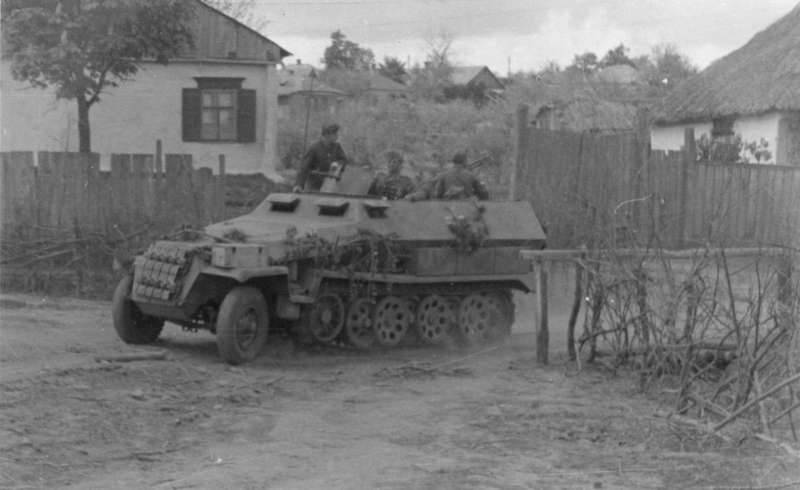
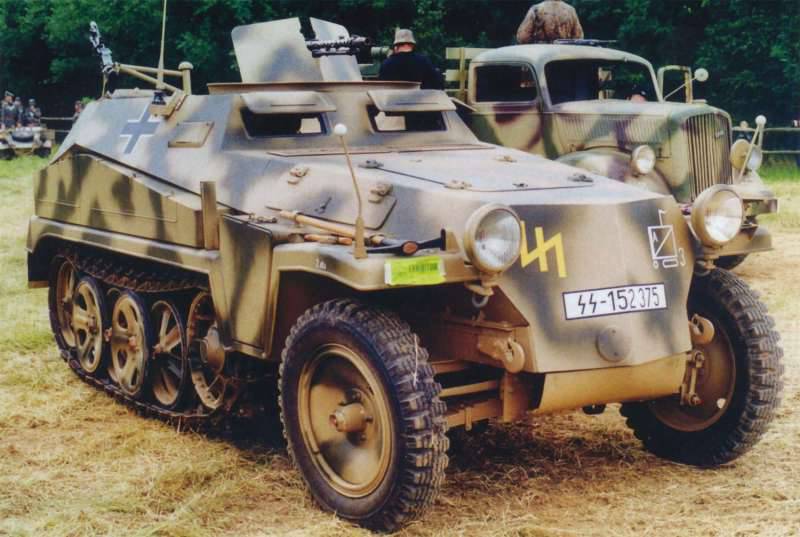
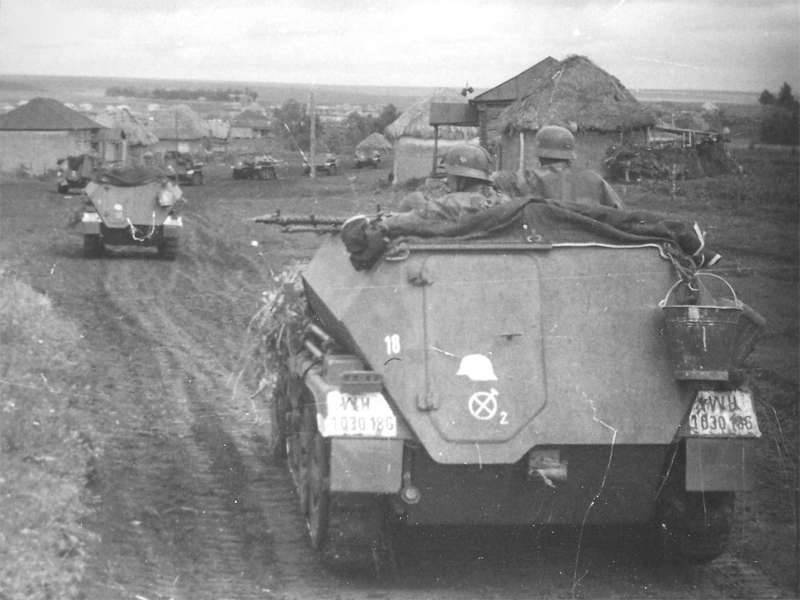
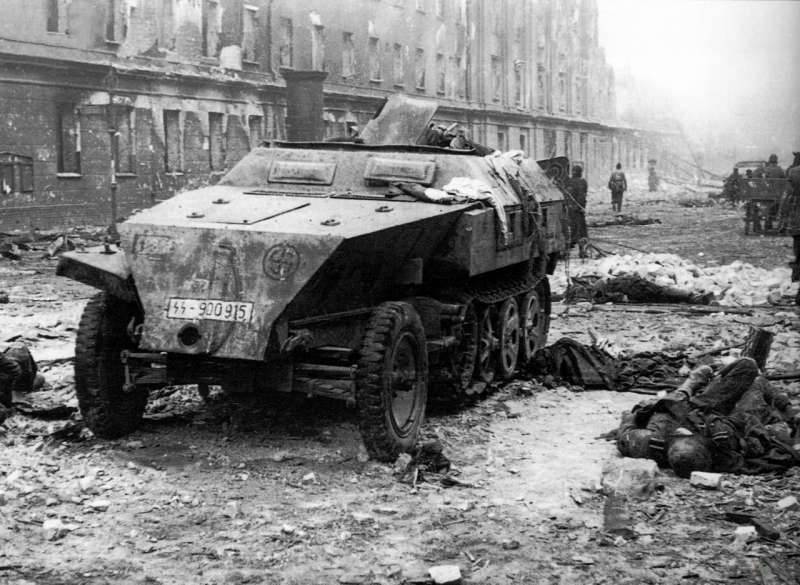
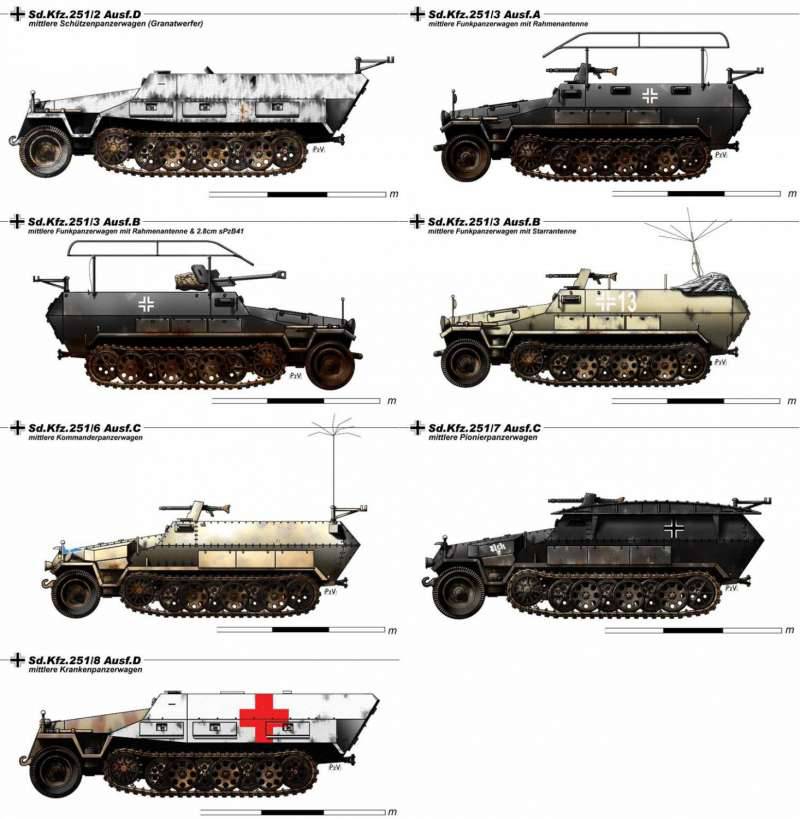
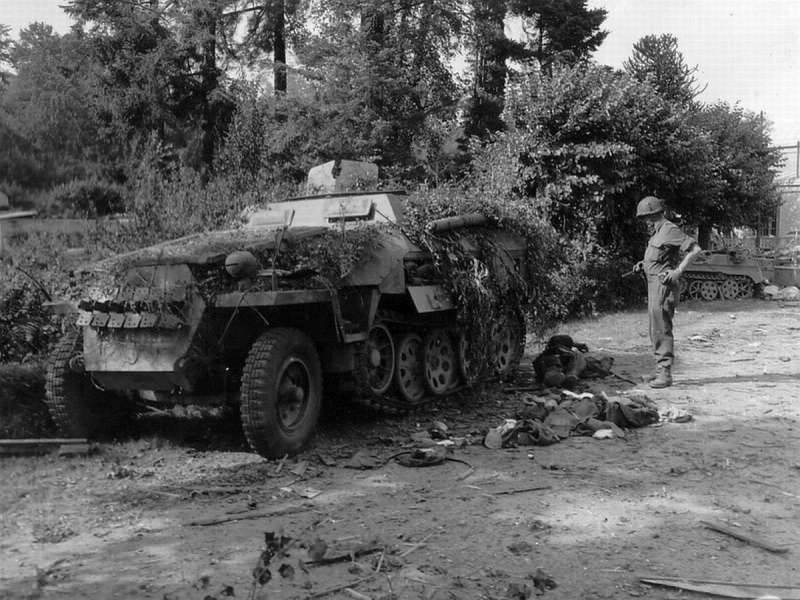
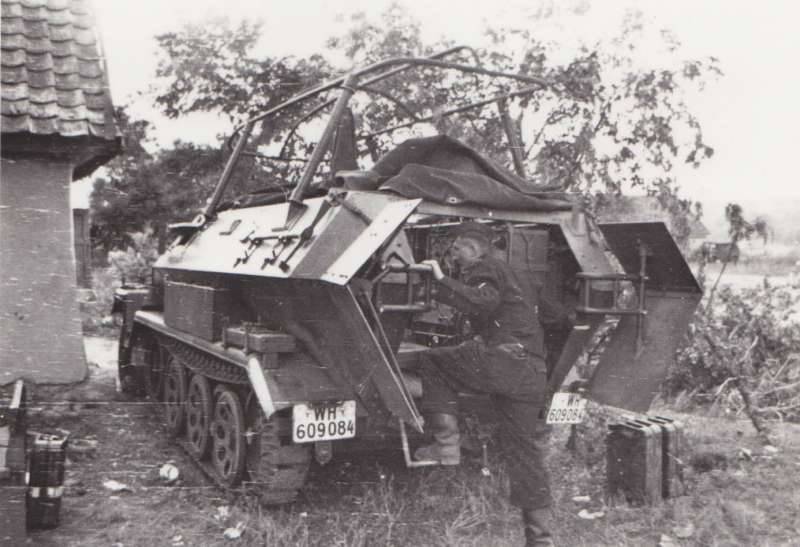
Information